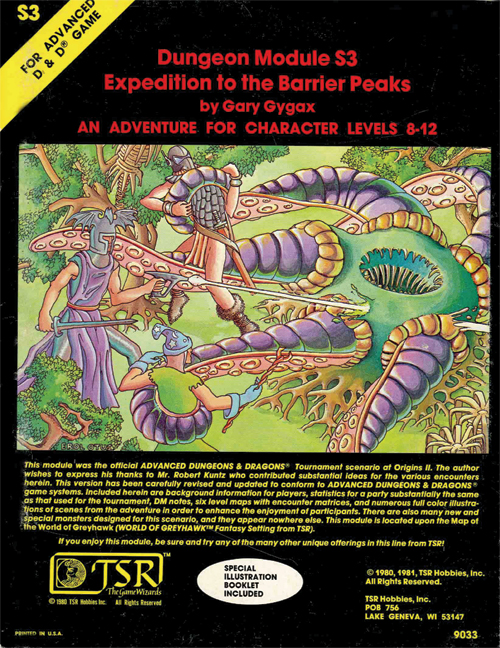Generally I’ll be discussing individual RPGs rather than specific modules, but AD&D module S3 holds such an important position in RPG history that I think an exception is warranted. Particularly as it constitutes the “missing link” behind the two games I’ve discussed most recently, Metamorphosis Alpha and Gamma World. Ironically, Expedition to the Barrier Peaks was originally conceived as a marketing tactic: in the spring of 1976, with TSR putting the finishing touches on Metamorphosis, Gary Gygax was pondering the problem of how best to introduce that science fiction game to the growing legions of D&D fans. MA creator James Ward had already game-mastered scenarios in which D&D parties were swept through rips in the space-time fabric to the world of the starship Warden; Gygax reversed this, conceiving of a tournament adventure in which science fiction came to the world of Greyhawk.
But in so doing, he needed something more accessible than Rob Kunz’ infamous “machine level” in Castle Greyhawk, where high-tech inventions vied with sorcery as part of what’s probably the largest dungeon ever made. Trying to “productize” Greyhawk would have been a titanic undertaking; even now, more than thirty years later, only the merest fragment of Castle Greyhawk has reached the marketplace. Gygax was looking for something more manageable—a single adventure that could be played out in classic tournament fashion.
And thus S3 was born (the S standing for special, denoting those modules not belonging to any larger series; S3’s predecessors being S1 Tomb of Horrors and S2 White Plume Mountain). Expedition centered on a lost starship crashlanding in the world of Greyhawk, creating one hell of a problem for the local barons when some of the creatures stored within it escaped and started terrorizing the surrounding countryside. The usual team of doughty adventurers were rounded up and sent to tackle the menace, only to stumble into a dungeon like nothing they’d ever seen. The robots and monsters of Expedition wreaked havoc in a series of brutal sessions, but Gygax had succeeded in his main objective: infusing the Origins II convention-goers with the techno-fantasy meme and priming the core D&D supporters for Metamorphosis Alpha.
Yet it was four more years before Expedition was released to the public at large. Gygax and his team had far too many other commitments—TSR was expanding beyond his wildest dreams, and it was all anyone could do to keep up. But in 1980, with Gamma World in the marketplace and needing all the support it could get, Gygax returned to his tournament notes and cranked out what became S3. It would be interesting to know what the thinking was in making Expedition one of the most lavishly illustrated adventures of all time (63 illustrations, 4 of those in full-color). Perhaps it was a recognition of how difficult DMs were going to find it to describe objects and locations that made no sense to the characters. Maybe TSR simply realized that if ever there was a module crying out to be illustrated with panache, it was this one. More likely, artist Erol Otus simply got inspired by the content and cranked out some of the most evocative drawings to ever grace a fantasy adventure.
 Befitting its unique status in the D&D canon, Expedition was structured in an untraditional manner. There was no final “mega-monster” waiting at the end, though there were certainly more than one encounter that could have served that purpose in a lesser module—primary candidates being the intellect devourer prowling the maintenance levels, the mind-flayer wielding the laser pistol, or the froghemoth that was the stuff of nightmares. Though I think the encounter that everybody tends to remember is the “wolf-in-sheep’s clothing,” which looked like a tree stump with a rabbit-like creature sitting atop it. . . but of course was really a multi-tentacled monstrosity.
Befitting its unique status in the D&D canon, Expedition was structured in an untraditional manner. There was no final “mega-monster” waiting at the end, though there were certainly more than one encounter that could have served that purpose in a lesser module—primary candidates being the intellect devourer prowling the maintenance levels, the mind-flayer wielding the laser pistol, or the froghemoth that was the stuff of nightmares. Though I think the encounter that everybody tends to remember is the “wolf-in-sheep’s clothing,” which looked like a tree stump with a rabbit-like creature sitting atop it. . . but of course was really a multi-tentacled monstrosity.
For their pains in battling these creatures—and should they be able to correctly utilize the key-cards that granted access to various parts of the ship—parties stood to acquire all manner of technology; indeed, a third of the module is dedicated to discussing the various guns and armor littered throughout the ship. In theory there was a limit to how destabilizing any tech items taken out of the ship could be; without an industrial base to support them, all the powered-armor and weaponry would ultimately run out of charges reasonably quickly. But in practice, a lot of D&D campaigns were never the same after this, since S3 showed all of us just how much fun it could be to mix and match across RPGs/genres. All the more so as we were all high on Empire Strikes Back at the time. Within weeks after S3 had been unleashed, our fourth grade class found itself battling it out with Star Destroyers above the world of Greyhawk. Expedition to the Barrier Peaks was well-named; there was no going back after you’d crossed ’em.
David J. Williams is the author of the Autumn Rain trilogy (The Mirrored Heavens, The Burning Skies, and the just-released The Machinery of Light). More about the world of the early 22nd century at www.autumnrain2110.com.










